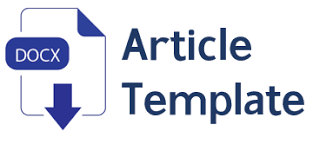PENGEMBANGAN MODEL PEMBELAJARAN SRM (SEARCHING, READING, MAPPING) BERBASIS HOTS UNTUK PENDIDIKAN LINGKUNGAN HIDUP PADA MAHASISWA PAUD
Abstract
Full Text:
PDFReferences
Abdullah, A. H., Mun, S. H., Mokhtar, M., Ashari, Z. M., Jumaat, N. F., Ali, D. F., Samah, N. A., & Abdurrahman, M. S. (2020). Using active learning with smart board to enhance primary school students’ higher order thinking skills in data handling. Universal Journal of Educational Research, 8(10), 4421–4432. https://doi.org/10.13189/ujer.2020.081009
Anderson, L. W., Krathwohl, D. R., Airiasian, W., Cruikshank, K. A., Mayer, R. E., Pintrich, P. R., Raths, J., & Wittrock, M. C. (2001). A taxonomy for learning, teaching and assessing: A revision of bloom’s taxonomy of educational objectives. Longman.
Branch, R. M. (2009). Instructional design: The ADDIE approach. In Department of Educational Psychology and Instructional Technology University of Georgia (Vol. 53, Issue 9). Springer.
Chen, S. J., Chou, Y. C., Yen, H. Y., & Chao, Y. L. (2015). Investigating and structural modeling energy literacy of high school students in Taiwan. Energy Efficiency, 8(4), 791–808. https://doi.org/10.1007/s12053-015-9327-5
Cheng, J. C. H., & Monroe, M. C. (2012). Connection to nature: Children’s affective attitude toward nature. Environment and Behavior, 44(1), 31–49. https://doi.org/10.1177/0013916510385082
Djamahar, R., Ristanto, R. H., Sartono, N., Ichsan, I. Z., & Muhlisin, A. (2018). CIRSA : Designing Instructional Kits to Empower 21 st Century Skill. Educational Process: International Journal, 7(3), 200–208. https://doi.org/10.22521/edupij.2018.73.4
Fitriati, F., Marlaini, M., & Elizar, E. (2021). Integrating rich task into the mathematics classroom to develop students’ higher order thinking skills: A collaborative action research study in a secondary school. Elementary Education Online, 20(1), 479–494. https://doi.org/10.17051/ilkonline.2021.01.042
Hadzhikolev, E., Hadzhikoleva, S., Yotov, K., & Orozova, D. (2020). Models for Multicomponent Fuzzy Evaluation, with a Focus on the Assessment of Higher-Order Thinking Skills. TEM Journal, 9(4), 1656–1662. https://doi.org/10.18421/TEM94-43
Husamah, Fatmawati, D., & Setyawan, D. (2018a). OIDDE learning model: Improving higher order thinking skills of biology teacher candidates. International Journal of Instruction, 11(2), 249–264. https://doi.org/10.12973/iji.2018.11217a
Husamah, H., Fatmawati, D., & Setyawan, D. (2018b). OIDDE learning model: improving higher order thinking skills of biology teacher candidates. International Journal of Instruction, 11(2), 249–264. https://doi.org/10.12973/iji.2018.11217a
Indawati, N. (2015). The Development of Anti-Corruption Education Course for Primary School Teacher Education Students. Journal of Education and Practice, 6(35), 48–54.
Khoiriyah, A. J., & Husamah, H. (2018). Problem-based learning: creative thinking skills, problem-solving skills, and learning outcome of seventh grade students. JPBI (Jurnal Pendidikan Biologi Indonesia), 4(2), 151–160. https://doi.org/10.22219/jpbi.v4i2.5804
Maclean, R., & Pavlova, M. (2017). What type of pedagogy is required in schools and classrooms to support sustainable green growth? A case study of Hong Kong within the international context. In Education in the Asia-Pacific Region (Vol. 38, pp. 101–119). Springer Nature. https://doi.org/10.1007/978-981-10-3654-5_7
Mahardika, I. K., Rasagama, I. G., Indrianto, L., Doyan, A., & Supeno. (2020). Validity of physical learning module based on multiple representation and higher order thinking skills (W. D. (ed.); Vol. 1465, Issue 1). Institute of Physics Publishing. https://doi.org/10.1088/1742-6596/1465/1/012057
Marconi, A., Schiavo, G., Zancanaro, M., Valetto, G., & Pistore, M. (2018). Exploring the world through small green steps: Improving sustainable school transportation with a game-based learning interface (C. T., M. A., L. F., & M. M. (eds.)). Association for Computing Machinery. https://doi.org/10.1145/3206505.3206521
Motallebzadeh, K., Ahmadi, F., & Hosseinnia, M. (2018). Relationship between 21st century skills, speaking and writing skills: A structural equation modelling approach. International Journal of Instruction, 11(3), 265–276. https://doi.org/10.12973/iji.2018.11319a
Rahayu, E., Susanto, H., & Yulianti, D. (2011). Pembelajaran Sains Dengan Pendekatan Keterampilan Proses Untuk Meningkatkan Hasil Belajar Dan Kemampuan Berpikir Kreatif Siswa. Jurnal Pendidikan Fisika Indonesia, 7, 106–110. https://doi.org/10.15294/JPFI.V7I2.1081
Ramadhan, S., Mardapi, D., Prasetyo, Z. K., & Utomo, H. B. (2019). The development of an instrument to measure the higher order thinking skill in physics. European Journal of Educational Research, 8(3), 743–751. https://doi.org/10.12973/eu-jer.8.3.743
Sadiqin, I. K., Santoso, U. T., & Sholahuddin, A. (2017). Students ’ difficulties on science learning with prototype problem-solving based teaching and learning material : a study evaluation of development research. Advances in Social Science, Education and Humanities Research, 100, 279–282.
Saputri, A. C., Sajidan, Rinanto, Y., Afandi, & Prasetyanti, N. M. (2019). Improving students’ critical thinking skills in cell-metabolism learning using Stimulating Higher Order Thinking Skills model. International Journal of Instruction, 12(1), 327–342. https://doi.org/10.29333/iji.2019.12122a
Saputro, A. D., Irwanto, Sri Atun, & Wilujeng, I. (2019). The impact of problem solving instruction on academic achievement and science process skills among prospective elementary teachers. Elementary Education Online, 18(2), 496–507. https://doi.org/10.17051/ilkonline.2019.561896
Subramaniam, P., Sulaiman, T., & Kamarudin, N. (2020). Relationship between higher order thinking and metacognitive skills with hands-on teaching among primary school science teachers in Jempol district. ASM Science Journal, 13. https://doi.org/10.32802/ASMSCJ.2020.SM26(2.19)
Talmi, I., Hazzan, O., & Katz, R. (2018). Intrinsic motivation and 21st-century skills in an undergraduate engineering project: the formula student project. Higher Education Studies, 8(4), 46. https://doi.org/10.5539/hes.v8n4p46
Wikanta, W., & Susilo, H. (2022). Higher Order Thinking Skills Achievement for Biology Education Students in Case-Based Biochemistry Learning. International Journal of Instruction, 15(4), 835–854. https://doi.org/10.29333/iji.2022.15445a
Yang, K. K., Lee, L., Hong, Z. R., & Lin, H. S. (2016). Investigation of effective strategies for developing creative science thinking. International Journal of Science Education, 38(13), 2133–2151. https://doi.org/10.1080/09500693.2016.1230685
Zohar, A., & Agmon, V. A. (2018). Raising test scores vs. teaching higher order thinking (hot): senior science teachers’ views on how several concurrent policies affect classroom practices. Research in Science and Technological Education, 36(2), 243–260. https://doi.org/10.1080/02635143.2017.1395332
Zulfiani, Suwarna, I. P., & Sumantri, M. F. (2020). Science adaptive assessment tool: Kolb’s learning style profile and student’s higher order thinking skill level. Jurnal Pendidikan IPA Indonesia, 9(2), 194–207. https://doi.org/10.15294/jpii.v9i2.23840
DOI: https://doi.org/10.46368/bjpd.v4i2.1494
Article Metrics
Abstract view : 51 timesPDF - 29 times
Refbacks
- There are currently no refbacks.

This work is licensed under a Creative Commons Attribution-ShareAlike 4.0 International License.

This work is licensed under a Creative Commons Attribution-NonCommercial-ShareAlike 4.0 International License.



